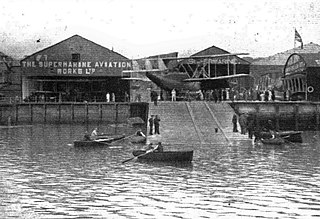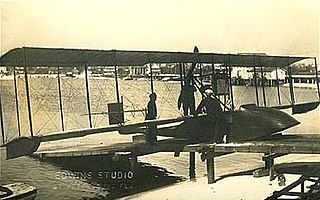
Supermarine was a British aircraft manufacturer that is most famous for producing the Spitfire fighter plane during World War II as well as a range of seaplanes and flying boats, and a series of jet-powered fighter aircraft after World War II. The company had successes in the Schneider Trophy for seaplanes, with three wins in a row of 1927, 1929 and 1931.

A seaplane is a powered fixed-wing aircraft capable of taking off and landing (alighting) on water. Seaplanes are usually divided into two categories based on their technological characteristics: floatplanes and flying boats; the latter are generally far larger and can carry far more. Seaplanes that can also take off and land on airfields are in a subclass called amphibious aircraft, or amphibians. Seaplanes were sometimes called hydroplanes, but currently this term applies instead to motor-powered watercraft that use the technique of hydrodynamic lift to skim the surface of water when running at speed.

Curtiss Aeroplane and Motor Company was an American aircraft manufacturer originally founded in 1909 by Glenn Hammond Curtiss and Augustus Moore Herring in Hammondsport, New York. After significant commercial success in its first decades, it merged with the Wright Aeronautical in 1929 to form Curtiss-Wright Corporation.
Short Brothers plc, usually referred to as Shorts or Short, is an aerospace company based in Belfast, Northern Ireland. Shorts was founded in 1908 in London, and was the first company in the world to make production aeroplanes. It was particularly notable for its flying boat designs manufactured into the 1950s.

The Naval Aircraft Factory (NAF) was established by the United States Navy in 1918 in Philadelphia, Pennsylvania. It was created to help solve aircraft supply issues which faced the Navy Department upon the entry of the U.S. into World War I. The US Army’s requirements for an enormous quantity of airplanes created a decided lack of interest among aircraft manufacturers in the Navy's requirements for a comparatively small quantity of aircraft. The Navy Department concluded that it was necessary to build a Navy-owned aircraft factory in order to assure a part of its aircraft supply; to obtain cost data for the department’s guidance in its dealings with private manufacturers; and to have under its own control a factory capable of producing experimental designs.

The Sopwith Aviation Company later Sopwith Aviation & Engineering Company was a British aircraft company that designed and manufactured aeroplanes mainly for the British Royal Naval Air Service, Royal Flying Corps and later Royal Air Force in the First World War, most famously the Sopwith Camel. Sopwith aircraft were also used in varying numbers by the French, Belgian, and American air services during the War.

This is a list of aviation-related events from 1912:

SPAD was a French aircraft manufacturer active between 1911 and 1921. Its SPAD S.XIII biplane was the most produced French fighter airplane of the First World War.

Antony Habersack Jannus, more familiarly known as Tony Jannus, was an early American pilot whose aerial exploits were widely publicized in aviation's pre-World War I period. He flew the first airplane from which a parachute jump was made, in 1912. Jannus was also the first airline pilot, having pioneered the inaugural flight of the St. Petersburg–Tampa Airboat Line on January 1, 1914, the first scheduled commercial airline flight in the world using heavier-than-air aircraft. The Tony Jannus Award, created to perpetuate his legacy, recognizes outstanding individual achievement in the scheduled commercial aviation industry and is conferred annually by the Tony Jannus Distinguished Aviation Society founded in Tampa, Florida, in 1963.

Hugh Armstrong Robinson was a pioneer in the earliest days of aviation, combining his skills of inventor, pilot, and daredevil. Among other things, he is said to have been the third person to successfully fly an aircraft after the Wright Brothers in a plane of his own design and construction and the first person to make an air-sea rescue. His many firsts also include the first medical flight transporting a doctor to patient in Hammond, N.Y. in June 1912 and first U.S. airmail flight in 1911. Robinson also devised the term and art of dive-bombing.

Blériot Aéronautique was a French aircraft manufacturer founded by Louis Blériot. It also made a few motorcycles between 1921 and 1922 and cyclecars during the 1920s.

The Tony Jannus Award recognizes outstanding individual achievement in scheduled commercial aviation by airline executives, inventors and manufacturers, and government leaders. The award is conferred annually by the Tony Jannus Distinguished Aviation Society and was first bestowed in 1964 in Tampa, Florida, U.S. Its namesake, aviation pioneer Tony Jannus, piloted the inaugural flight of the St. Petersburg–Tampa Airboat Line on January 1, 1914, the first scheduled commercial airline flight in the world using heavier-than-air aircraft. In addition to preserving the legacy of Tony Jannus, the non-profit Society also offers financial assistance to college students pursuing studies in aviation and conducts an annual essay contest for high school students to encourage careers in aviation.

The Benoist XIV, also called The Lark of Duluth, was a small biplane flying boat built in the United States in 1913 in the hope of using it to carry paying passengers. The two examples built were used to provide the first heavier-than-air airline service anywhere in the world, and the first airline service of any kind at all in the United States.

Aéroplanes Hanriot et Cie. or simply 'Hanriot' was a French aircraft manufacturer with roots going back to the beginning of aviation. Founded by René Hanriot in 1910 as The Monoplans Hanriot Company Ltd. the company survived in different forms until 1916 when it established itself with the Hanriot-Dupont (HD.) fighters and observation aircraft. The company lasted through several takeovers and structural changes until in 1936 it merged with Farman to become the Société Nationale de Constructions Aéronautiques du Centre (SNCAC). 'Central Air Works' consortium.

Franco-British Aviation was an aircraft manufacturer of the early 20th century, headquartered in London and with its production facilities around Paris. Specialising in seaplanes, it was established in 1913 by Louis Schreck and André Beaumont.

The St. Petersburg–Tampa Airboat Line was the first scheduled airline using a fixed wing aircraft. The airline provided service between St. Petersburg, Florida and neighboring Tampa across Tampa Bay a distance of about 23 miles. It was in service from January to May 1914.

Albert Jewell was an early US aviator who disappeared off Long Island, New York, on October 13, 1913, en route to Oakwood, Staten Island, in order to take part in The New York Times American Aerial Derby. No confirmed trace of Jewell or his aircraft was ever recovered. At the time, the press compared his likely fate to that of Cecil Grace and Edouard Jean Bague, who disappeared during flights over water.
St. Louis Aircraft Corporation was an American aircraft manufacturer founded in September 1917.

Thomas W. Benoist was an American aviator and aircraft manufacturer. In an aviation career of only ten years, he formed the world's first aircraft parts distribution company, established one of the leading early American aircraft manufacturing companies and a successful flying school, and from January to April 1914 operated the world's first scheduled airline.

Russell Froelich (1890–1958) was an American photographer who lived in St. Louis, Missouri. He is known for his aerial photography as well as his photographs of local St. Louis culture. He also spent time designing and building aircraft.

















